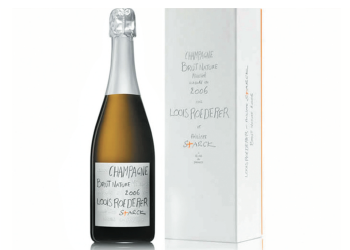Wither The Wine World’s Middlemen?

Louis Roederer and Philippe Starck unveil new Brut Nature 2006 cuvee
What would happen if the three-tier system of wine and liquor distribution disappeared? For some, it would be a nightmare, for others a fabulous dream. But the subject is ripe with discussion and points of contention from both sides. How would something like this ever come to pass?
The three-tier system thrives in the U.S., whereby any alcohol beverage goes from producer to wholesaler/distributor, then to a retail store or restaurant, which is then sold to the end consumer. Each time the alcoholic beverage changes hands, the government takes a cut (in taxes). For foreign wine/liquor there is the one added step of importation.
Some would say that this system is kept in place to protect large wholesalers and distributors. But that is only partly true. The system also favors a huge number of producers.Yes, that’s right, probably even one of your favorite wine producers benefits from the three-tier system.
First, let us take the very large producer: a BIG brand that sells something on the order of 1 million cases. These producers do not have to, nor would they want to pay for the infrastructure to warehouse, sell and deliver their product around the country. Can you imagine if you produced your wine in California yet had to send it all the way to New York, warehouse it, and build a team of salespeople to deliver it yourself? That is a huge investment. Makes sense for a large producer, right?
What about a smaller producer? OK, let’s take a winery that makes 50,000 cases, but may not be very well known outside its local market. How would it build a presence, market its wine and deliver its wine
without the help of a distributor/wholesaler infrastructure?
Importers feel this even more keenly, as the foreign wines that they import are completely unknown to the domestic market. The wines are made from different, often esoteric and unfamiliar grapes with names very few can pronounce. Without the help of the distributor/wholesaler, these types of producers would not be able to grow, or maybe not even sell, through their entire production within a year’s time, which is bad for their business plans. The only type of producers that do not benefit from distributors and wholesalers are the wineries and or liquor producers that sell every single one of the bottles they produce directly to a mailing list and/or private clientele. And the number of producers in this class is tiny.
Let’s talk dollars and cents for a minute. Did you know that when a distributor purchases wine from a producer, it must pay its bill typically within 30 days? In some states, if the distributor does not pay on time, it pays fines and risks further reprimands, including having its license revoked. Although producers may offer a distributor a lower price than what they charge directly to the public, the assurance of being paid on a timely basis is more than attractive — it is essential.
The other side of the coin argues that there is less competition because the large producers and distributors/wholesalers push their products and push out their competition. Some also argue that the end product price would be a lot less if there were fewer hands touching it before it ends up in the final consumer’s glass. Some decry distributors/wholesalers for pushing “corporate” wines versus “artisanal.”
All are valid points, although I could argue against each.
The biggest challenge to the three-tier system is the Internet, which, as we know, currently is skidding by somehow without being taxed (although I’m sure the government has other plans). Online companies, such as Amazon, eBay and Alibaba, if allowed, legally could take over the same role that distributors/wholesalers have today. They could send a drone to deliver your case of wine or vodka mere hours after you placed the order. They already have warehousing, and they are as close to you as a click of a button. Who knows what the future holds?
Recommendations: 2006 Louis Roederer Brut Nature ($99) This terrific Champagne has zero dosage, so it is drier than brut and comes from the amazing 2006 vintage. It is creamy and citrus at the same
time, with notes of bread and nuts. It is the first “new” Champagne from the house of Roederer in 50 years! BTW: The label was designed by Philippe Starck, one of Roederer’s biggest fans. Try this with oysters, clam chowder and even seafood salads. 2013 Pomelo Sauvignon Blanc ($12) zesty, light, flowery and delicious — everything you want in an easy-drinking Sauvignon Blanc. It hints toward tropical papaya fruit and is my choice as a “porch pounder.” Have it with mussels, sautéed white fish in butter with capers, or anything with crab. Both can be found at Fujioka’s Wine Times.





